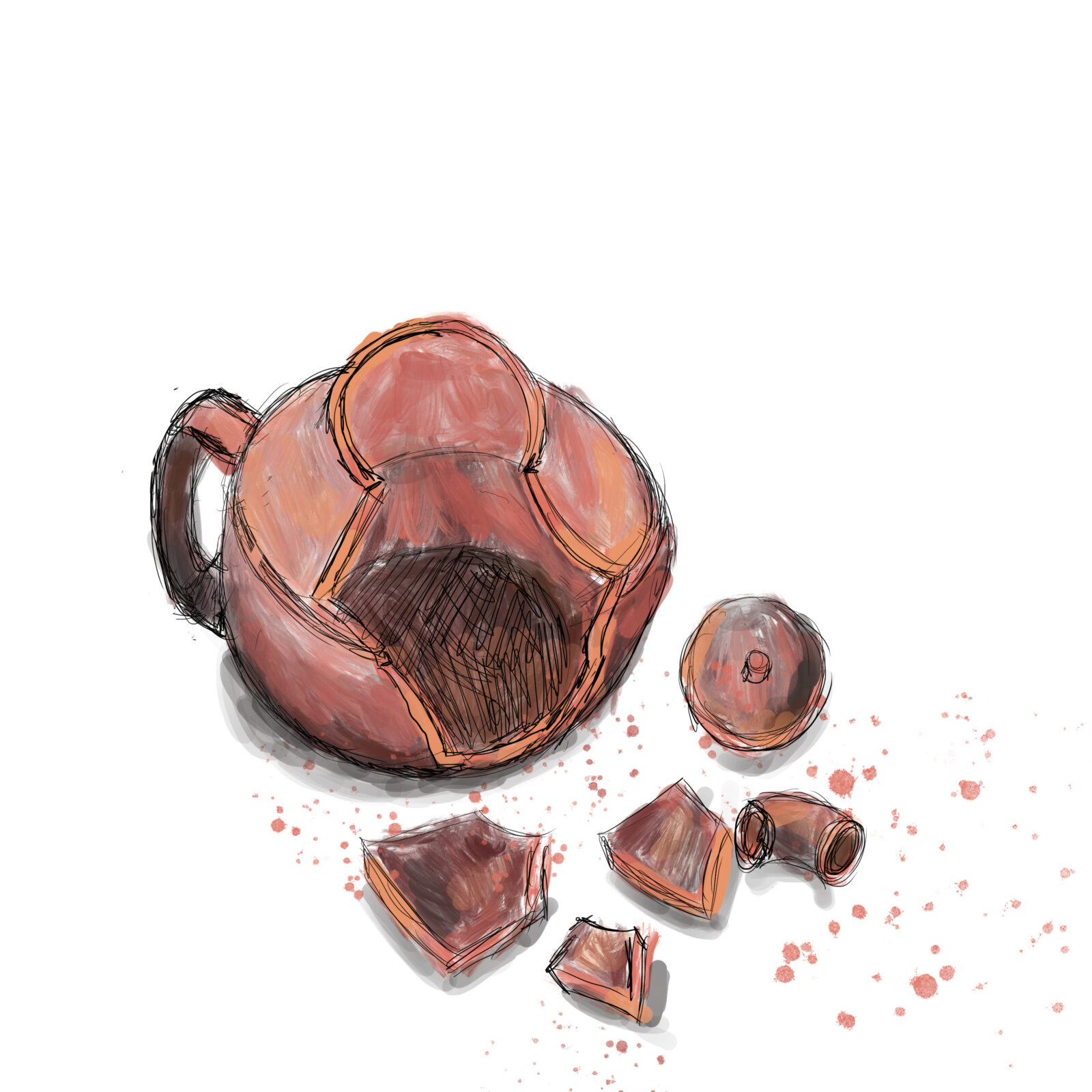
Lama (Teacher), Milarepa; Tibet; 18th century; ground mineral pigment on cotton; Rubin Museum of Art; gift of Shelley and Donald Rubin; C2006.66.460 (HAR 921).

Lama (Teacher), Milarepa; Tibet; 18th century; ground mineral pigment on cotton; Rubin Museum of Art; gift of Shelley and Donald Rubin; C2006.66.460 (HAR 921).
Milarepa, the great mystical poet of Tibet, once found himself with only a single possession of any worth: his cooking pot. To enhance his practice and escape from the distractions of everyday life, he was living and meditating high in the mountains, where the pot served as the means to prepare his meager but welcome meals of boiled nettles. One day, while leaving his meditation cave with the pot on his back, Milarepa slipped—the pot rolled down the mountainside and shattered. Others might have been devastated by the loss of their last possession, but Milarepa was amazed. Filled with inspiration, he sang a yogic song that begins, “I once had a pot, now I do not.” It ends:
This clay pot so important, the whole of my wealth,
Becomes my lama in the moment it breaks,
Teaching impermanence, how amazing!1
Milarepa’s song is an evocative expression of the central role that impermanence plays in Buddhism. From the earliest days of the Buddhist tradition, impermanence figures as a key element in the challenges of the human condition. Yet while we constantly encounter impermanence everywhere, it is also said to be something that we try desperately to ignore. As such impermanence is a frequent motif in Buddhist practice, and contemplations of impermanence often assume a progression—one we will briefly explore here—from the obvious to the subtle ways that impermanence features in our lives.
On the most obvious level impermanence manifests as death. For the Buddhist practitioner the refusal to acknowledge the inevitability of death is one of the first obstacles to overcome. Our denial of death is pervasive, and it often involves a blind confidence that today is not the last day of my life. Blithely going through the day in this way, we allow the mind to be captured by the unimportant, the distracting, and the trivial.
Traditionally Tibetan practitioners thus begin each day with a contemplation of death and impermanence (‘chi ba mi rtag pa in Tibetan) as one of the main methods to redirect the mind (blo ldog) toward what really matters. That contemplation can become remarkably elaborate and challenging, with intense visualizations of oneself on a deathbed, filled with regret for a wasted life, surrounded by relatives who cannot help. Other contemplations compel the practitioner to acknowledge that the fantasy of not dying is—rather obviously—just a fantasy. Can we identify anyone who has lived more than, say, 130 years? Do people often die while thinking that they will surely live a little longer, with plans and projects unfinished? Do sudden, catastrophic events—aneurysms, accidents, environmental disasters—take life, even of the young, in just an instant? These and other such contemplations are not meant to ruin your day. Rather they are intended to bring you back to what really matters.

Impermanence also manifests on a subtler level, and here the traditional notion of the suffering of change (‘gyur ba’i sdug bsngal) comes to the fore. This powerful Buddhist insight shows us that our experiences, even of the greatest pleasure, are fundamentally unstable. Living in Wisconsin, where we value all things dairy, I have the luxury of enjoying amazing ice cream produced by my own university at the famed Babcock Hall in Madison. Yet my tremendous pleasure in the anticipation of a few tasty scoops would pale in comparison to my displeasure at the prospect of having ice cream, and only ice cream, at every meal for the next month. The key to the suffering of change is just this: even our usual pleasures can become painful, because pleasure itself is inherently unstable. Even our intimate loves, for example, can somehow become so estranged that we no longer tolerate their presence.
Finally, at the subtlest level, impermanence underlies even our ordinary perceptions. Choose any visual object in front of you right now (or attend to a physical sensation such as the feeling of your feet on the floor). When you move your attention to another object and then return to the original one, has anything changed? Is the thing you were looking at (or feeling) exactly the same? The Buddhist view, intriguingly confirmed by modern science, is that no thing remains exactly the same even for an instant. Any causally efficacious thing—that is, anything that arises from causes and produces effects—is necessarily changing in each moment, because to be caught up in a causal world requires a state of constant flux.
This applies to our most basic perceptions. In each moment we are coming into relation to a perceptual object, and this requires our minds to be inherently in flux. If consciousness itself were completely unchanging, then how would we experience anything new? Even the most basic level of our sensory experience involves an ongoing, subtle degree of impermanence or flux. In short, life is inherently unstable, and the more we deny that instability the more we invite the suffering that comes from the moments when we realize that such denials were only wishful thinking.
As Roshi Joan Halifax of Upaya Zen Center recently remarked to me, Buddhism can seem rather dour. We might get the impression that the aim of these contemplations is to make us feel like life is a bummer. Certainly when we ignore the challenges of the human condition, it probably is a good thing to be jolted out of that willful ignorance. But the overall point of contemplating death and impermanence is not about pain and dissatisfaction. It’s about the tremendous opportunities offered by the inevitability of change, the novelty of each moment, and the immediacy of beauty and pleasure. To put it another way, the fantasy of permanence imprisons us, but the reality of impermanence can set us free.
1. Tsangnyon Heruka, The Life of Milarepa, trans. Andrew Quintman, Penguin Classics (New York: Penguin Books, 2010), 150.

John Dunne is Distinguished Professor of Contemplative Humanities at the University of Wisconsin–Madison. His work focuses on Buddhist philosophy and contemplative practice, especially in dialogue with cognitive science. His publications range from technical works on Buddhist epistemology to broader works on the nature of Buddhist contemplative practices, such as mindfulness. Dr. Dunne speaks in both academic and public contexts. In addition to serving as a faculty member for the Center for Healthy Minds, he is a Fellow of the Mind and Life Institute, where he has previously served on the Board of Directors. Dr. Dunne also serves as an academic advisor for the Ranjung Yeshe Institute.
Get the latest news and stories from the Rubin, plus occasional information on how to support our work.